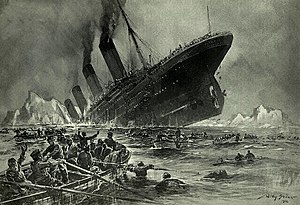
Back غرق آر إم إس تيتانيك Arabic Fundimientu del RMS Titanic AST Потъване на „Титаник“ Bulgarian টাইটানিকের নিমজ্জন Bengali/Bangla Enfonsament del Titanic Catalan نقومبوونی تایتانیکی ئار ئێم ئێس CKB Βύθιση του Τιτανικού Greek Dronado de Titanic Esperanto Hundimiento del RMS Titanic Spanish غرق شدن کشتی تایتانیک Persian
 The sinking of the Titanic depicted in Untergang der Titanic, a 1912 illustration by Willy Stöwer | |
| Date | 14–15 April 1912 |
|---|---|
| Time | 23:40–02:20 (02:38–05:18 GMT)[a] |
| Duration | 2 hours and 40 minutes |
| Location | North Atlantic Ocean, 370 miles (600 km) southeast of Newfoundland |
| Coordinates | 41°43′32″N 49°56′49″W / 41.72556°N 49.94694°W |
| Type | Maritime disaster |
| Cause | Collision with an iceberg on 14 April |
| Participants | Titanic crew and passengers |
| Outcome | Maritime policy changes; SOLAS |
| Deaths | 1,490–1,635 |
RMS Titanic sank on 15 April 1912 in the North Atlantic Ocean. The largest ocean liner in service at the time, Titanic was four days into her maiden voyage from Southampton, England, to New York City, with an estimated 2,224 people on board when she struck an iceberg at 23:40 (ship's time)[a] on 14 April. She sank two hours and forty minutes later at 02:20 ship's time (05:18 GMT) on 15 April resulted in the deaths of more than 1,500 people, making it one of the deadliest peacetime maritime disasters in history.
Titanic received six warnings of sea ice on 14 April but was travelling at a speed of roughly 22 knots (41 km/h) when her lookouts sighted the iceberg. Unable to turn quickly enough, the ship suffered a glancing blow that buckled her starboard side and opened six of her sixteen compartments to the sea. Titanic had been designed to stay afloat with up to four of her forward compartments flooded, and the crew used distress flares and radio (wireless) messages to attract help as the passengers were put into lifeboats. In accordance with existing practice, the Titanic's lifeboat system was designed to ferry passengers to nearby rescue vessels, not to hold everyone on board simultaneously; therefore, with the ship sinking rapidly and help still hours away, there was no safe refuge for many of the passengers and crew with only twenty lifeboats, including four collapsible lifeboats. Poor preparation for and management of the evacuation meant many boats were launched before they were completely full.
Titanic sank with over a thousand passengers and crew still on board. Almost all of those who ended up in the water died within minutes due to the effects of cold shock and incapacitation. RMS Carpathia arrived about an hour and a half after the sinking and rescued all of the 710 survivors by 09:15 on 15 April. The disaster shocked the world and caused widespread outrage over the lack of lifeboats, lax regulations, and the unequal treatment of third-class passengers during the evacuation. Subsequent inquiries recommended sweeping changes to maritime regulations, leading to the establishment in 1914 of the International Convention for the Safety of Life at Sea (SOLAS) which still governs maritime safety today.
Cite error: There are <ref group=lower-alpha> tags or {{efn}} templates on this page, but the references will not show without a {{reflist|group=lower-alpha}} template or {{notelist}} template (see the help page).
- ^ Halpern 2011, p. 78.